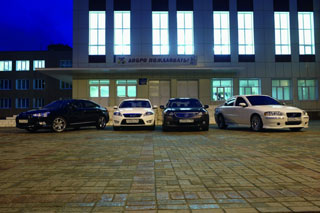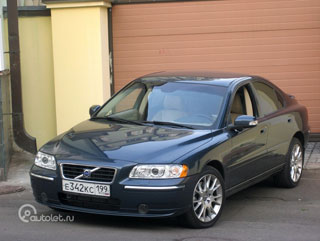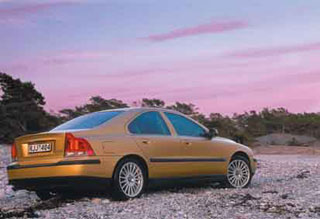Wilvo S40 test drive since 2007 sedan
Volvo S60. V70. XC70
 It is possible to distinguish the updated Volvo S60/V70/XC70 from predecessors only if you know in advance what you should pay attention to. The appearance of the cars remained almost untouched, and all changes were more practical than cosmetic.
It is possible to distinguish the updated Volvo S60/V70/XC70 from predecessors only if you know in advance what you should pay attention to. The appearance of the cars remained almost untouched, and all changes were more practical than cosmetic. Small strokes
What is primarily subjected to alteration when the appearance of the car decides to refresh? That which is easier and cheaper to change is optics and bumpers, less often wings. The Volvo decided to limit themselves to the very minimum, setting new headlights and rear lights in the old place and giving new strokes to the front and rear bums. Moreover, if the bumpers have changed to more harmonize the appearance, then the new lighting technology has practical advantages over the previous one. In accordance with the current trends for the formation of a light bundle, headlight reflections are now fully responsible, and transparent plastic caps are used instead of glass-deflectors. Such headlights and lanterns are easier, much less suffer from pebbles falling into them and do not injure pedestrians with their fragments, which have managed to be in the way of the car. In addition, a new radiator grille appeared on the XC70 SUV, giving the car a slightly more formidable look. Of course, there is nothing to see the external changes, but they don’t look for good from good, you should not radically change the so successful and harmonious appearance of the cars, if it is not outdated in three years from the beginning of the release.
 In the cabin, too, everything is familiar, and innovations concern primarily to the increase in the comfort of its inhabitants. The driver and the front passenger will probably like new front seats, and everyone, without exception, will come in handy for a multifunctional central armrest containing a box for any little things that you want to keep at hand, and four cup holders, and a small table that can use not only the front ones, but And the rear passengers. The new design of the gear lever and its masks for the top version of the S60 is noteworthy-now all this is trimmed with aluminum and looks stylish and in sporting.
In the cabin, too, everything is familiar, and innovations concern primarily to the increase in the comfort of its inhabitants. The driver and the front passenger will probably like new front seats, and everyone, without exception, will come in handy for a multifunctional central armrest containing a box for any little things that you want to keep at hand, and four cup holders, and a small table that can use not only the front ones, but And the rear passengers. The new design of the gear lever and its masks for the top version of the S60 is noteworthy-now all this is trimmed with aluminum and looks stylish and in sporting. First of all - security
But this is far from all that has changed in cars. In contrast to the cases of facelifting in its pure form, when, in addition to the new eyes and a slightly changed facial expression, cars remain completely the same, in our case the main news is technical, first of all, of course, concerning security. It has already become familiar that Volvo invents and launches various systems in the series before other manufacturers, designed to warn or at least reduce the severity of its consequences. On the S60/V70, we were invited to test the BLIS system in the case, which includes radars mounted in the mirrors that control the dead areas on the left and to the right of the car.
 We have already talked about how the system works (see No. 6, 2004), so we will only briefly recall the principles. The radars control zones 3 m wide and 9.5 m long on the right and to the left of the car. If in this zone there is another machine with which a collision is possible, a warning yellow signal lights up from the corresponding side in the front view. Such a system is used on a passenger car for the first time. Another novelty, however, is already familiar from other models, is the front side glasses and side mirrors with a water -repellent coating that significantly improve visibility in rainy weather compared to ordinary glasses. Another help in increasing safety can be considered the second generation of the adaptive suspension Four-C, which can now be installed on the Volvo of the 60th and 70th series by order. The essence of her work is that she constantly monitors the condition of the road surface and the driver’s behavior and, in accordance with these data, changes the characteristics of the damping of shock absorbers, continuously adjusting to the road and under the driving manner. Moreover, the system can work in two algorithms - sports and comfortable.
We have already talked about how the system works (see No. 6, 2004), so we will only briefly recall the principles. The radars control zones 3 m wide and 9.5 m long on the right and to the left of the car. If in this zone there is another machine with which a collision is possible, a warning yellow signal lights up from the corresponding side in the front view. Such a system is used on a passenger car for the first time. Another novelty, however, is already familiar from other models, is the front side glasses and side mirrors with a water -repellent coating that significantly improve visibility in rainy weather compared to ordinary glasses. Another help in increasing safety can be considered the second generation of the adaptive suspension Four-C, which can now be installed on the Volvo of the 60th and 70th series by order. The essence of her work is that she constantly monitors the condition of the road surface and the driver’s behavior and, in accordance with these data, changes the characteristics of the damping of shock absorbers, continuously adjusting to the road and under the driving manner. Moreover, the system can work in two algorithms - sports and comfortable.  Gifts to drivers
Gifts to drivers Volvo is gradually moving away from the image of cars, which, in addition to the fact that they are safe, have nothing to say. For some time now, Scandinavians take into account the interests of people who love and can ride quickly, time after time making more driver's cars. So the S60 T5 is moving further along this path. The modified motor develops 260 hp. Instead of 250 hp, and the torque is 350 nm instead of 330 nm. At the same time, at the mark of 1800 rpm, the engine develops 305 Nm instead of the previous 240 nm, and the maximum reaches the moment at 2100 rpm and remains unchanged up to 5000 rpm. Swedish motorists achieved these indicators through several changes. Firstly, from 2.3 to 2.4 liters, the working volume was increased, secondly, now the phases of not only release, but also in-the-third, are now adjusted, and thirdly, a turbine from the Volvo S60R/V70R was installed on the motor. In a couple to the engine from sports R-modifications, a 6-speed gearbox also migrated. And the Swedes changed the steering supplier, and now it has become more accurate and transparent, although, I admit, there were no complaints about the previous design. Finally, on modifications of the S60 T5 and V70 T5 from 286 to 316 mm, the diameter of the front brake discs was increased. Such gifts are subtle connoisseurs of high art of aerobatics.
 Diesel for Europe
Diesel for Europe We decided to start our test program with a diesel XC70 with a mechanical checkpoint. The first surprise was waiting when touched: when trying to move smoothly, the car simply stalled. The clutch drive and the characteristic of the torque of the diesel engine are the fault - the long -flowing tight pedal without any feedback, completely deprives the moment to feel the moment when the clutch begins to take, and the motor at revolutions up to 1,500 practically does not develop traction. It is necessary to start from 2500 rpm so that the engine does not fall into the turboyam, while still forcing the clutch to slip more than usual. It is inconvenient, and the clutch is sorry. It was not impressed by the ride on a diesel machine - a narrow working range of the engine makes it constantly wielded the gearbox lever, and although the clarity of the switching is excellent, long adhesion pedal moves make the gear shift procedure completely joyless. And when I had to twist in a traffic jam, albeit small by Moscow standards, it finally became clear that it was better to buy a diesel car with an automatic gearbox. True, all this will not affect the situation in the Russian market, we have no diesel cars in honor, so let Europeans train the left leg.
 A completely different matter is gasoline motors. And with a machine gun, and with mechanics, and a sedan, and station wagon - cars are going well. As for the 6-speed gearbox, then with such a wide range of maximum traction, five steps would have been enough. However, these cars will be bought by people who enjoy the process of switching and well able to use the advantages that the mechanical box gives. With such an engine in calm mode, you can easily switch through the program, and if you need to go in sports mode, you can use all six. In a word, in accordance with the road situation and necessity, you can choose an algorithm for switching to your taste. It was not possible to fully test the Four-C suspension primarily because all the cars presented for the test were equipped with it, and therefore it was not possible to compare its work with the work of a conventional suspension. If we talk about sensations, then they are the following. The difference between sports and comfortable modes with a calm rhythm of movement along a good road is practically not felt. But the higher the speed and the worse the road, the more this difference is noticeable.
A completely different matter is gasoline motors. And with a machine gun, and with mechanics, and a sedan, and station wagon - cars are going well. As for the 6-speed gearbox, then with such a wide range of maximum traction, five steps would have been enough. However, these cars will be bought by people who enjoy the process of switching and well able to use the advantages that the mechanical box gives. With such an engine in calm mode, you can easily switch through the program, and if you need to go in sports mode, you can use all six. In a word, in accordance with the road situation and necessity, you can choose an algorithm for switching to your taste. It was not possible to fully test the Four-C suspension primarily because all the cars presented for the test were equipped with it, and therefore it was not possible to compare its work with the work of a conventional suspension. If we talk about sensations, then they are the following. The difference between sports and comfortable modes with a calm rhythm of movement along a good road is practically not felt. But the higher the speed and the worse the road, the more this difference is noticeable. Actually, nothing unusual: in comfortable mode, small ripples reaches a lesser extent, but the car hangs a little on large waves, and in sports mode the relief of the road is much more distinct, but the body behaves very stably. Probably, unlike cars with a regular suspension, a machine equipped with Four-C is better adapted to different
 road conditions. Both on autobahns and on winding roads with not always even asphalt the car behaved equally well, but how great the merit of the adaptive suspension is only after a comparative test. With all the positive aspects, the suspension settings did not seem perfect - in comfortable mode I would like the better filtration of small irregularities, otherwise hints of vertical buildup appear, and small blows still reach the body to a greater extent than you expect. However, this is not very manifested very much, and if you evaluate the work of Four-C on a five-point scale, then you can remove no more than half a point.
road conditions. Both on autobahns and on winding roads with not always even asphalt the car behaved equally well, but how great the merit of the adaptive suspension is only after a comparative test. With all the positive aspects, the suspension settings did not seem perfect - in comfortable mode I would like the better filtration of small irregularities, otherwise hints of vertical buildup appear, and small blows still reach the body to a greater extent than you expect. However, this is not very manifested very much, and if you evaluate the work of Four-C on a five-point scale, then you can remove no more than half a point. Side arbitrators
Still moving along the streets of Mainz, we began to study the operation of the BLIS system. I must admit, there were fears that the system would behave annoyingly, now and then recalling: the car on the left! Car right! However, in fact, it turned out that the Swedes thought out everything very carefully. A small yellow light, sunbathing in the front rack, does not distract attention at all and resembles a good side referee in football with its behavior. His business
 fix the violation and raise the flag, and even the chief judge decides whether to look at him or not, take into account his signals or ignore it. The same can be said in relation to the driver. And, by the way, in both cases, much depends on the qualifications of the whose hands are the reins of government, and those who are on the flanks are only assistants who do not have the right to interfere in the decision -making process. True, throughout the test day there was sunny weather and everything that Blis warned about was visible in the mirrors, good, the review in them is very good. But, I think, in bad weather, and even at night, this option will not be superfluous at all, again it can sometimes save from the setup. And if Blis blinds for any reason, she will immediately warn the driver about it so that he costs himself on his own.
fix the violation and raise the flag, and even the chief judge decides whether to look at him or not, take into account his signals or ignore it. The same can be said in relation to the driver. And, by the way, in both cases, much depends on the qualifications of the whose hands are the reins of government, and those who are on the flanks are only assistants who do not have the right to interfere in the decision -making process. True, throughout the test day there was sunny weather and everything that Blis warned about was visible in the mirrors, good, the review in them is very good. But, I think, in bad weather, and even at night, this option will not be superfluous at all, again it can sometimes save from the setup. And if Blis blinds for any reason, she will immediately warn the driver about it so that he costs himself on his own. Facing the driver
What is the impression of cars in general? If several years ago Volvo were sold under the slogan of Revolvolution, today they are best suitable for another, more calm - Evolvolution. The Swedish company is systematically moving along the chosen path, remaining at the forefront of the struggle for safety and at the same time gradually giving its cars the features that were not peculiar to them before. Cars with a symbol of Mars on a radiator grill are increasingly corresponding to the nature inherent in the god of war. Volvo becomes more powerful, aggressive, more precise and faster, but at the same time, fortunately, Volvo remains strong reliable machines that instill calm and confidence in the driver and passengers. And all these changes take place smoothly, calmly - as the Scandinavians are used to living, doing everything slowly and conscience.
 Some technical characteristics of Volvo S60 T5
Some technical characteristics of Volvo S60 T5 (manufacturer data)
Dimensions, mm: 4580x1810x1430
Base, mm: 2720
Front/behind, mm: 1560/1540
Diameter of the turn, m: 11.8
Equipped mass, kg: 1440
Engine type: gasoline in a 5-cylinder gasoline with turbocharged
Working volume, cubic meter. See: 2401
Max. Power, L.S./rpm: 260/5500
Max. moment, nm/rpm: 350/2100-5200
Transmission: automatic 5-band or mechanical 6-speed
Max. Speed, km/h: 250
Acceleration time 0-100 km, C: 6.9/6.5*
Fuel consumption (average), l/100 km: 10.0/9.2*
Top volume, l: 70
* For versions with a mechanical gearbox.
Leonid Klimanovich




Source: Avtopanorama magazine








